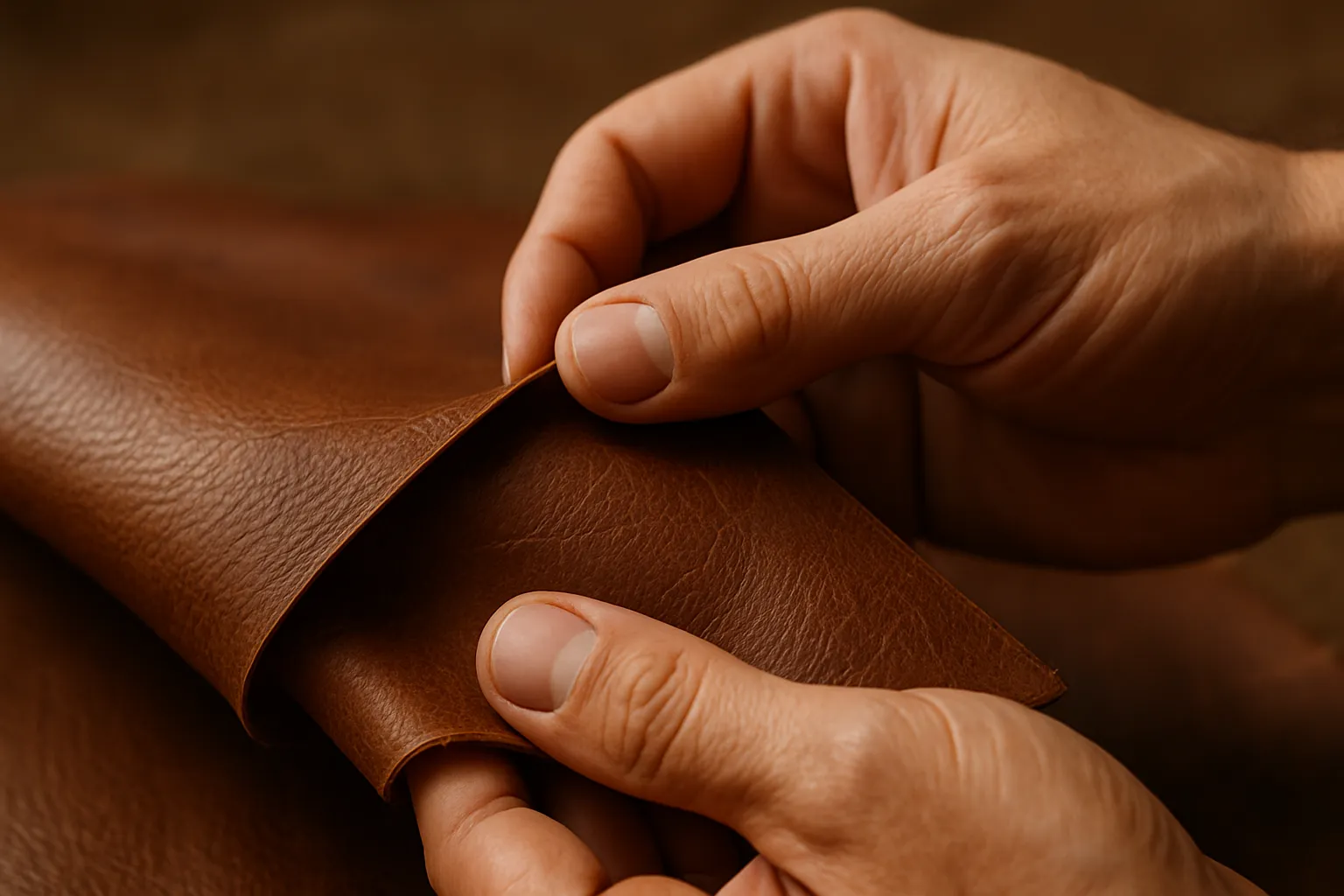How to Identify Real Leather: 7 Proven Ways to Spot Genuine Quality

When investing in leather goods, knowing how to distinguish real leather from synthetic alternatives is essential. Whether you're shopping for a luxury handbag, a pair of handcrafted sandals, or a bespoke wallet, these seven proven methods will help you spot genuine/full-grain leather quality with confidence.
Why Identifying Real Leather Matters
Genuine/full-grain leather isn't just about prestige. Real leather offers superior durability, develops a beautiful patina over time, and when properly cared for, can last decades. Synthetic alternatives may look similar initially, but they lack the longevity, breathability, and unique character that only authentic leather provides.
At RADI Leather, we work exclusively with premium genuine/full-grain leather, ensuring every piece we craft meets the highest standards of quality and authenticity.
1. The Touch Test: Feel the Texture
What to look for: Genuine/full-grain leather has a unique texture that synthetic materials struggle to replicate perfectly.
Real leather feels warm to the touch and slightly grainy. When you press your finger against it, the surface should wrinkle naturally, similar to skin. The texture is never perfectly uniform because it comes from an animal hide with natural variations.
Pro tip: Run your fingers across the surface. Genuine leather feels soft yet firm, with a natural give. Faux leather often feels plasticky, overly smooth, or has an artificial grain pattern that repeats perfectly across the surface.
2. The Smell Test: Trust Your Nose
What to look for: Authentic leather has a distinctive, earthy aroma that's impossible to fake convincingly.
Real leather carries a rich, natural scent that's often described as musky, earthy, or woody. This smell comes from the tanning process and the organic nature of the hide itself. Once you've experienced it, you'll recognize it instantly.
Warning sign: If the item smells like plastic, chemicals, or has a sharp synthetic odor, it's likely not genuine leather. Some manufacturers try to add artificial leather scent, but it never quite matches the real thing.
3. The Water Drop Test: Watch the Absorption
What to look for: How the material reacts to moisture reveals its true nature.
Place a small drop of water on an inconspicuous area of the leather. Genuine/full-grain leather is porous and will absorb the water gradually, darkening slightly where the drop landed. After a few seconds, the water should begin to soak in.
What happens with fake leather: Synthetic materials are typically water-resistant, causing the droplet to bead up and sit on the surface without being absorbed. While some treated genuine/full-grain leathers are also water-resistant, this test combined with others will help you determine authenticity.
Important: Always test in a hidden area, as water can temporarily stain some leathers.
4. The Visual Inspection: Look for Natural Imperfections
What to look for: Real leather tells a story through its natural markings.
Examine the surface closely under good lighting. Genuine/full-grain leather will show subtle imperfections like small scars, wrinkles, pores, or slight color variations. These are not defects but rather proof of authenticity. Each hide is unique, and no two pieces of real leather are exactly identical.
Red flag: If the grain pattern is too perfect, repeats identically, or looks printed on, you're likely looking at synthetic material. Machine-made faux leather often has an artificial, stamped appearance.
5. The Edge Test: Check the Sides
What to look for: The edges of leather goods reveal important clues about authenticity.
Inspect the edges or any cut sections of the material. Real leather edges appear fibrous and rough, showing the layered structure of the hide. High-quality leather goods often have finished edges that are burnished, painted, or turned inward.
Synthetic giveaway: Faux leather edges typically look like fabric with a plastic coating, showing a textile base with a thin coating on top. The edge may appear fuzzy (from the fabric base) with a plastic layer that can peel away.
6. The Flexibility Test: Bend and Crease It
What to look for: How the material responds to movement and pressure.
Gently bend or press the leather to create temporary creases. Genuine leather is supple and flexible, creating natural wrinkles that resemble skin. When you release the pressure, real leather returns to its original shape with soft wrinkles that fade.
Fake leather behavior: Synthetic materials often resist bending naturally, may crack when bent sharply, or create stiff, unnatural folds. Some faux leathers are too stiff, while others are overly flexible without the substance of real leather.
7. The Flame Test: Use with Extreme Caution
What to look for: Different materials react distinctively to heat (use this as a last resort only).
Warning: Only perform this test on a tiny, hidden area with extreme caution, as it can damage the material.
Real leather is naturally flame-resistant to a degree. If you briefly touch a small, hidden edge with a flame, genuine/full-grain leather will not catch fire easily. It may singe slightly and give off a smell like burning hair (since it's animal protein).
Synthetic reaction: Faux leather, being plastic-based, will melt, curl, or catch fire more readily, producing a chemical smell and often leaving behind melted plastic residue.
Recommendation: This test should be your last resort, as it can permanently damage the item. Use the previous six methods first.
Additional Indicators of Quality Leather
Check the Label
Reputable manufacturers clearly label their products as "genuine/full-grain leather," "full-grain leather," or "top-grain leather." Be wary of vague terms like "man-made materials," "vegan leather," or "leatherette," which indicate synthetic materials.
Price Point Reality
While price alone doesn't guarantee authenticity, genuine/full-grain leather goods typically cost more than synthetic alternatives due to material costs and craftsmanship involved. If a "leather" bag is unusually cheap, investigate further.
Ask About the Source
Don't hesitate to ask retailers or artisans about their leather source and tanning process. Craftspeople who work with genuine/full-grain leather, like our team at RADI Leather, are proud to discuss their materials and methods.
Understanding Leather Types
Not all genuine leather is created equal. Here's a quick reference:
Full-Grain Leather: The highest quality, using the entire grain with no corrections. Shows all natural markings and develops the best patina.
Top-Grain Leather: The second-highest quality, with the very top layer sanded and refinished for uniformity. Still genuine and durable.
Genuine Leather: A legal term meaning real leather, but typically refers to lower quality splits or corrected grain leather.
Bonded Leather: Made from leather scraps bonded with adhesive. Technically contains real leather but behaves more like synthetic material.
Why Choose Authentic Leather from RADI
At RADI Leather, every piece we create is handcrafted from premium genuine/full-grain leather in our Sri Lankan atelier. We believe in transparency, quality, and the timeless beauty of authentic materials. When you invest in a RADI creation, you're not just purchasing a product; you're acquiring a handcrafted piece that will develop character and serve you for years to come.
Our award-winning designs, from the celebrated Leather Box Bag to bespoke creations, showcase what genuine leather can become in skilled hands. Each item carries the unmistakable markers of authenticity: natural grain variations, rich aroma, and the supple feel that only real leather provides.
Conclusion: Trust Your Senses
Identifying real leather becomes easier with practice. By combining these seven methods, you'll develop a reliable instinct for spotting genuine quality. Remember that authentic leather is an investment in longevity, sustainability, and timeless style.
The next time you're considering a leather purchase, take a moment to perform these tests. Your senses—touch, smell, and sight—are powerful tools for distinguishing the real from the replica.
Ready to experience authentic craftsmanship? Explore our collection of handcrafted leather goods, where every piece is guaranteed genuine and made to last a lifetime.
Have questions about leather quality or care? Contact our team at RADI Leather, where tradition meets imagination in every handcrafted creation.

